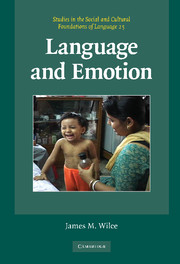Book contents
- Frontmatter
- Contents
- List of figures
- List of transcripts
- Acknowledgements
- Introduction
- Part I Theory
- 1 Defining the domain
- 2 The relationship of language and emotion
- 3 Approaches to language and emotion
- 4 The panhuman and the particular
- Part II Language, power, and honor
- Part III Identification and identity
- Part IV Histories of language and emotion
- Notes
- Glossary
- References
- Index
- STUDIES IN THE SOCIAL AND CULTURAL FOUNDATIONS OF LANGUAGE
2 - The relationship of language and emotion
Published online by Cambridge University Press: 05 June 2012
- Frontmatter
- Contents
- List of figures
- List of transcripts
- Acknowledgements
- Introduction
- Part I Theory
- 1 Defining the domain
- 2 The relationship of language and emotion
- 3 Approaches to language and emotion
- 4 The panhuman and the particular
- Part II Language, power, and honor
- Part III Identification and identity
- Part IV Histories of language and emotion
- Notes
- Glossary
- References
- Index
- STUDIES IN THE SOCIAL AND CULTURAL FOUNDATIONS OF LANGUAGE
Summary
Where shall we locate emotion (or affect, used broadly, following Kulick and schieffelin 2004) vis-à-vis language? any list of the elements, or layered structures, that make up language or discourse would suffice as a list of places emotion might appear. The loci of emotion in language are as numerous as locusts in a plague: phonology and sound symbolism, morphological processes (including reduplication), lexicon, syntax, discourse structure. Affect also emerges in the emergent text-like, even poetic, features of discourse, and in the relation of utterance or text to context. Each of these loci explodes into hundreds of possibilities.
The question of the location of affect in language is analogous to the question of the relationship of language to “cultural concepts” (Silverstein 2004). Summing up several decades of linguistic anthropological findings, Silverstein lists the ways in which language-in-use signals cultural conceptualizations. Taken together we can see them as problematizing both referentialism – the dominant language ideology in the West, defined in chapter 1– and any sharp distinction between reference and the constitution and performance of social identities or acts of identification. a referentialist view of language and emotion asks about the truth-value of various emotion-denoting features in the world's languages. in contrast, a pragmatic approach focuses on how emotion talk works in social life (lutz 1988: 8). We should note, however, that the structural unfolding (emergent entextualization) of what becomes recognizable as denotational text – simultaneously with interactional text – is the richest site for linguistic-anthropological investigation in general (silverstein 2004: 633), and for an analysis of languageand- emotion in particular.
- Type
- Chapter
- Information
- Language and Emotion , pp. 39 - 54Publisher: Cambridge University PressPrint publication year: 2009

